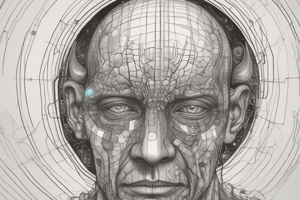Podcast
Questions and Answers
What is the main focus of cognitive science?
What is the main focus of cognitive science?
- Studying memory, perception, and decision-making mechanisms (correct)
- Providing a qualitative analysis of experiences
- Understanding conscious experiences
- Describing subjective experiences in detail
How does phenomenology differ fundamentally from cognitive science?
How does phenomenology differ fundamentally from cognitive science?
- It incorporates computational modeling for understanding cognition
- It uses quantitative data for analysis
- It relies on neuroimaging techniques
- It emphasizes subjective experiences over objective measurement (correct)
What methodological approach does cognitive science primarily rely on?
What methodological approach does cognitive science primarily rely on?
- Introspection and subjective reporting
- Philosophical inquiry without empirical evidence
- Narrative analysis and case studies
- Experimental methods and neuroimaging (correct)
Which of the following best describes the essence of phenomenology?
Which of the following best describes the essence of phenomenology?
What is a key characteristic of the cognitive science approach?
What is a key characteristic of the cognitive science approach?
What role does introspection play in phenomenological methodology?
What role does introspection play in phenomenological methodology?
In the context provided, what does 'nihilating organization' refer to?
In the context provided, what does 'nihilating organization' refer to?
What is the central aim of phenomenologists in their studies?
What is the central aim of phenomenologists in their studies?
What process do artificial neural networks (ANNs) use to learn from output errors?
What process do artificial neural networks (ANNs) use to learn from output errors?
Which application area has ANNs been particularly successful in surpassing classical models?
Which application area has ANNs been particularly successful in surpassing classical models?
What is a key feature of the mind according to the modularity theory in cognitive science?
What is a key feature of the mind according to the modularity theory in cognitive science?
What does nativism posit regarding cognition?
What does nativism posit regarding cognition?
Which principle indicates that twins of the same genetic makeup show more similarity than those with different genetics?
Which principle indicates that twins of the same genetic makeup show more similarity than those with different genetics?
What implication do universally experienced visual illusions suggest about cognitive architecture?
What implication do universally experienced visual illusions suggest about cognitive architecture?
What is a characteristic of the Fusiform Face Area (FFA) based on studies conducted by Arcaro et al.?
What is a characteristic of the Fusiform Face Area (FFA) based on studies conducted by Arcaro et al.?
According to Turkheimer's Laws of Behavioral Genetics, what is said about family effects compared to genetic ones?
According to Turkheimer's Laws of Behavioral Genetics, what is said about family effects compared to genetic ones?
What cognitive advantage was tracked by Borst & Anderson in their study using EEG?
What cognitive advantage was tracked by Borst & Anderson in their study using EEG?
Which brain structure did Schapiro et al. study in relation to structured learning?
Which brain structure did Schapiro et al. study in relation to structured learning?
Falk et al. utilized neural activity to predict which behavior change more effectively?
Falk et al. utilized neural activity to predict which behavior change more effectively?
What aspect of individual differences did Schwarzkopf et al. associate with the visual area V1?
What aspect of individual differences did Schwarzkopf et al. associate with the visual area V1?
What method did Meshulam et al. use to study representational learning?
What method did Meshulam et al. use to study representational learning?
What did the Ancient Egyptians associate with brain injury?
What did the Ancient Egyptians associate with brain injury?
According to Aristotle’s Heart Hypothesis, what organ was thought to be the center of emotion and reasoning?
According to Aristotle’s Heart Hypothesis, what organ was thought to be the center of emotion and reasoning?
What triggers a neuron to fire an action potential?
What triggers a neuron to fire an action potential?
What is the role of spatial arrangements of excitatory and inhibitory inputs in retinal cells?
What is the role of spatial arrangements of excitatory and inhibitory inputs in retinal cells?
How does Spike Timing Dependent Plasticity (STDP) affect synapse strength?
How does Spike Timing Dependent Plasticity (STDP) affect synapse strength?
What is the significance of visual cortex maps?
What is the significance of visual cortex maps?
What is a primary function of the V1 area in the visual cortex?
What is a primary function of the V1 area in the visual cortex?
Which mechanism is primarily responsible for supporting unsupervised learning in biological systems?
Which mechanism is primarily responsible for supporting unsupervised learning in biological systems?
What does prosopagnosia indicate about face recognition?
What does prosopagnosia indicate about face recognition?
What effect did Banerjee et al. (2012) find related to mood and perception?
What effect did Banerjee et al. (2012) find related to mood and perception?
Which of the following best describes the part-whole effect in face recognition?
Which of the following best describes the part-whole effect in face recognition?
What do phonotactic rules in linguistics govern?
What do phonotactic rules in linguistics govern?
What characteristic of language do recursive rules enable?
What characteristic of language do recursive rules enable?
Which statement regarding the limitations of animal communication is accurate?
Which statement regarding the limitations of animal communication is accurate?
Which language is noted to lack the 'th' sound?
Which language is noted to lack the 'th' sound?
In tree diagrams used in linguistics, what is primarily illustrated?
In tree diagrams used in linguistics, what is primarily illustrated?
Study Notes
Phenomenology and Cognitive Science
- Phenomenology aims to describe conscious experience without reducing it to underlying mechanisms
- Cognitive science seeks to understand cognitive mechanisms and information processing structures
- Phenomenology uses introspection and qualitative analysis while cognitive science uses experimental methods
Artificial Neural Networks
- ANNs learn by adjusting weights based on output errors during training using backpropagation
- ANNs excel in tasks like image recognition and language generation, surpassing classic models, as seen in ImageNet (2012)
- ANNs are "black box" systems where internal processes are difficult to understand
Nature vs. Nurture
- Nativism argues that cognition is genetically preprogrammed with brain regions developing autonomously
- Empiricism argues that cognitive processes emerge from environmental exposure
- Face processing in the Fusiform Face Area (FFA) suggests a nature-based explanation for its development, as macaques raised without exposure to faces lack typical face-processing abilities (Arcaro et al., 2017)
- Visual illusions, like the Ponzo illusion, that are universally experienced imply a shared cognitive architecture
Heritability Studies
- Twin studies show that traits like intelligence and personality exhibit varying degrees of heritability, with identical twins being more similar than fraternal twins
- Turkheimer's Laws of Behavioral Genetics state:
- All traits are heritable
- Family effects are smaller than genetic ones
- A portion of trait variation is unexplained by genes or families
Modularity
- The modularity theory states that the mind consists of specialized, independent modules responsible for specific tasks, operating with encapsulation, specialization, and localization
- Studies suggest low-level perception may be modular, but top-down effects can influence low-level sensory processing
- Mood experiments reveal that thinking about unethical behavior can make a room appear darker (Banerjee et al., 2012)
- Physical load experiments demonstrate that carrying a heavy backpack can make hills appear steeper (Bhalla & Prof tt, 1999)
- Face categorization experiments have found that Black faces appear darker due to categorization biases (Levin & Banaji, 2006)
- Face perception, particularly prosopagnosia, indicates that face recognition is modular: individuals with this condition recognize non-faces but not faces
- The part-whole effect, where recognizing a face part is easier when seen as part of a whole face, further supports modularity
Linguistics and Syntax
- Humans uniquely combine words to convey complex ideas, demonstrating linguistic competence (Pinker, 1994)
- Phonotactics, the rules governing the sound structure of a language, demonstrate the structured sounds permissible in each language
- French lacks the “th” sound
- Japanese con ates "l" and "r" sounds
- Hawaiian prohibits codas (syllable endings)
- Recursive rules in syntax allow for infinitely complex sentences by embedding phrases within phrases, as seen in cumulative sentences like "This is the cat that chased the mouse..."
Applications of Neuroimaging
- EEG can track timing in cognitive stages, predicting retrieval speed differences in different conditions (Borst and Anderson, 2021)
- fMRI studies have demonstrated:
- Hippocampal activation in response to learned sequences, observable even in infants (Schapiro et al., 2018)
- Neural activity in the medial frontal cortex can predict behavior change (Falk et al., 2011)
- The size of visual area V1 correlates with the strength of visual illusions, suggesting low-level interactions (Schwarzkopf et al., 2011)
- Shared spatial activity patterns in the brain for similar concepts in learning environments (Meshulam et al., 2021)
Brain Structure and Function
- Ancient Egyptians linked brain injury to mental symptoms as early as the 17th century BC
- Aristotle's Heart Hypothesis (4th century BC) positioned the heart as the center of sensation, arguing that emotions and pain are manifested through physical responses
- The structure of neurons and synaptic connections, fundamental for information transmission, were discovered by Santiago Ramón y Cajal in the late 1800s
Basic Brain Processes
- Neurons fire when their voltage exceeds a threshold due to excitatory inputs, sending spikes down the axon
- Synapses modulate neuronal firing, either increasing (excitatory) or decreasing (inhibitory) the likelihood of an action potential
Learning Mechanisms
- Spike Timing Dependent Plasticity (STDP):
- Strengthens synapses if a presynaptic spike precedes a postsynaptic spike (increases weight)
- Weakens them if it follows (decreases weight) (Zhang et al., 1998)
- Supports unsupervised learning by enhancing sensitivity to input patterns without specific goals or feedback
Cortical mapping
- Visual cortex maps show retinotopic and orientation-specific organization, structuring visual inputs spatially and by stimulus orientation (Heeger, 2006)
- Different brain areas handle unique aspects of sensory processing, supporting object recognition and spatial memory (Felleman & Van Essen, 1991)
Studying That Suits You
Use AI to generate personalized quizzes and flashcards to suit your learning preferences.
Related Documents
Description
Test your understanding of cognitive science and phenomenology, two fields that explore consciousness and cognitive processes. This quiz will cover key concepts such as artificial neural networks, nature vs. nurture debates, and the methodologies employed in both disciplines.




